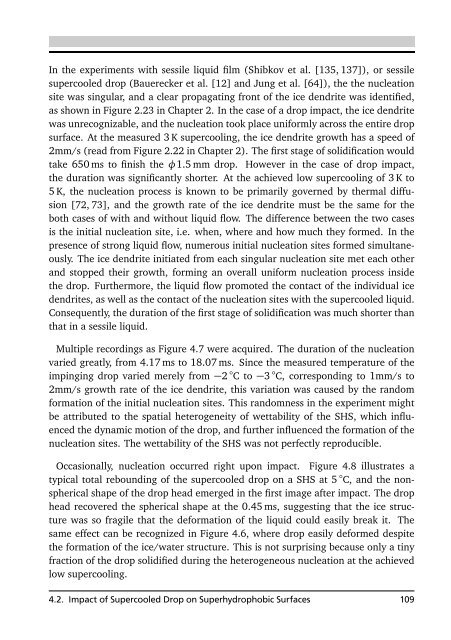front page - tuprints - Technische Universität Darmstadt
front page - tuprints - Technische Universität Darmstadt
front page - tuprints - Technische Universität Darmstadt
You also want an ePaper? Increase the reach of your titles
YUMPU automatically turns print PDFs into web optimized ePapers that Google loves.
In the experiments with sessile liquid film (Shibkov et al. [135, 137]), or sessile<br />
supercooled drop (Bauerecker et al. [12] and Jung et al. [64]), the the nucleation<br />
site was singular, and a clear propagating <strong>front</strong> of the ice dendrite was identified,<br />
as shown in Figure 2.23 in Chapter 2. In the case of a drop impact, the ice dendrite<br />
was unrecognizable, and the nucleation took place uniformly across the entire drop<br />
surface. At the measured 3 K supercooling, the ice dendrite growth has a speed of<br />
2mm/s (read from Figure 2.22 in Chapter 2). The first stage of solidification would<br />
take 650 ms to finish the φ1.5 mm drop. However in the case of drop impact,<br />
the duration was significantly shorter. At the achieved low supercooling of 3 K to<br />
5 K, the nucleation process is known to be primarily governed by thermal diffusion<br />
[72, 73], and the growth rate of the ice dendrite must be the same for the<br />
both cases of with and without liquid flow. The difference between the two cases<br />
is the initial nucleation site, i.e. when, where and how much they formed. In the<br />
presence of strong liquid flow, numerous initial nucleation sites formed simultaneously.<br />
The ice dendrite initiated from each singular nucleation site met each other<br />
and stopped their growth, forming an overall uniform nucleation process inside<br />
the drop. Furthermore, the liquid flow promoted the contact of the individual ice<br />
dendrites, as well as the contact of the nucleation sites with the supercooled liquid.<br />
Consequently, the duration of the first stage of solidification was much shorter than<br />
that in a sessile liquid.<br />
Multiple recordings as Figure 4.7 were acquired. The duration of the nucleation<br />
varied greatly, from 4.17 ms to 18.07 ms. Since the measured temperature of the<br />
impinging drop varied merely from −2 ◦ C to −3 ◦ C, corresponding to 1mm/s to<br />
2mm/s growth rate of the ice dendrite, this variation was caused by the random<br />
formation of the initial nucleation sites. This randomness in the experiment might<br />
be attributed to the spatial heterogeneity of wettability of the SHS, which influenced<br />
the dynamic motion of the drop, and further influenced the formation of the<br />
nucleation sites. The wettability of the SHS was not perfectly reproducible.<br />
Occasionally, nucleation occurred right upon impact. Figure 4.8 illustrates a<br />
typical total rebounding of the supercooled drop on a SHS at 5 ◦ C, and the nonspherical<br />
shape of the drop head emerged in the first image after impact. The drop<br />
head recovered the spherical shape at the 0.45 ms, suggesting that the ice structure<br />
was so fragile that the deformation of the liquid could easily break it. The<br />
same effect can be recognized in Figure 4.6, where drop easily deformed despite<br />
the formation of the ice/water structure. This is not surprising because only a tiny<br />
fraction of the drop solidified during the heterogeneous nucleation at the achieved<br />
low supercooling.<br />
4.2. Impact of Supercooled Drop on Superhydrophobic Surfaces 109
















